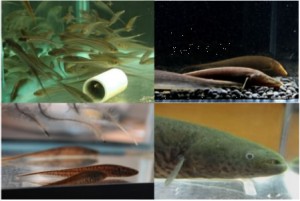For my dissertation research I studied dynamic regulation of communication signals in Neotropical gymnotiform electric fish in the lab of Philip Stoddard. Gymnotiform fish (commonly called knife fish) produce very weak electric signals that they use to navigate the murky waters of rivers and streams in South America and to communicate with each other.
There are over 250 species of electric fish and each species has a different communication signal, varying in complexity and plasticity (ability to change in response to changes in the social environment).

Different species of electric fish have different communicaiton signals, exhibit different aggregation patterns, and aggression levels.
Clockwise from top left: Eigenmannia virescens, Apteronotus leptorhynchus, Electrophorus electricus, Brachyhypopomus gauderio.
I showed that in gymnotiforms electric signal plasticity reflects hormone sensitivity and species-specific sociality.
Related publications:
Gavassa S, Goldina A, Silva A, Stoddard PK. 2013. Behavioral ecology, endocrinology, and signal reliability of electric communication. Journal of Experimental Biology, 216 (13):2403-2411.
Goldina A, Gavassa S, Stoddard PK. 2011. Testosterone and 11-ketotestosteone have different regulatory effects on electric communication signals of Brachyhypopomus gauderio. Hormones and Behavior 60(2):139-147
Markham MR, Allee SJ, Goldina A, Stoddard PK. 2009. Melanocortins regulate the electric waveforms of gymnotiform electric fish. Hormones and Behavior. 55: 306-313.
Manuscripts in prep:
Goldina A, Stoddard PK. Hormonally regulated signal plasticity tracks sociality across gymnotiform electric fish. Will be submitted to Hormones and Behavior
Goldina A, Crampton WGR, Markham RM, Stoddard PK. Radiation of dynamic communication signals through differential melanocortin sensitivity in the gymnotiform electric fish. Will be submitted to Journal of Experimental Biology